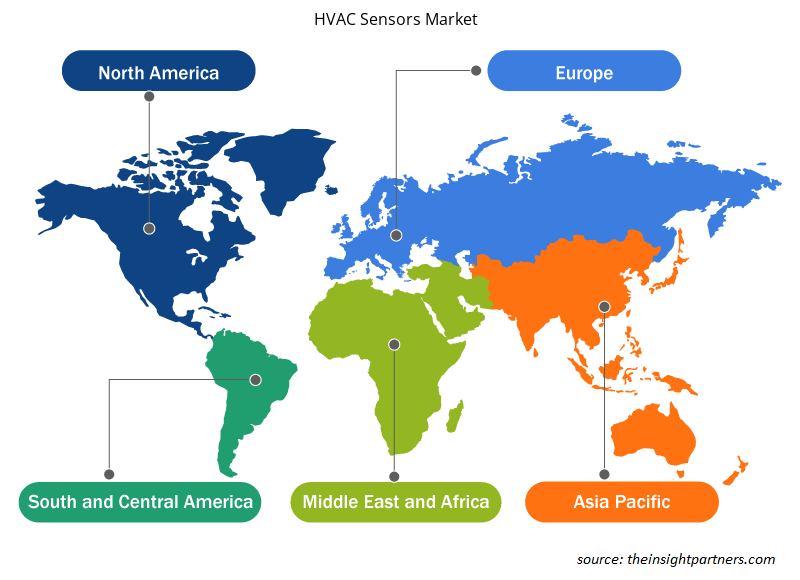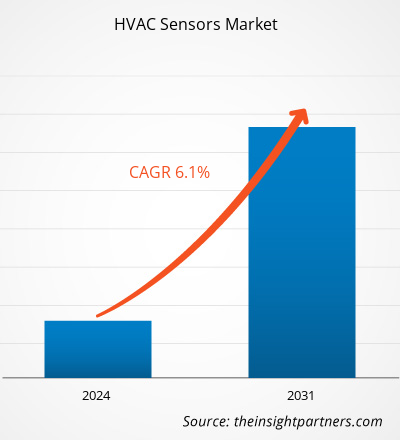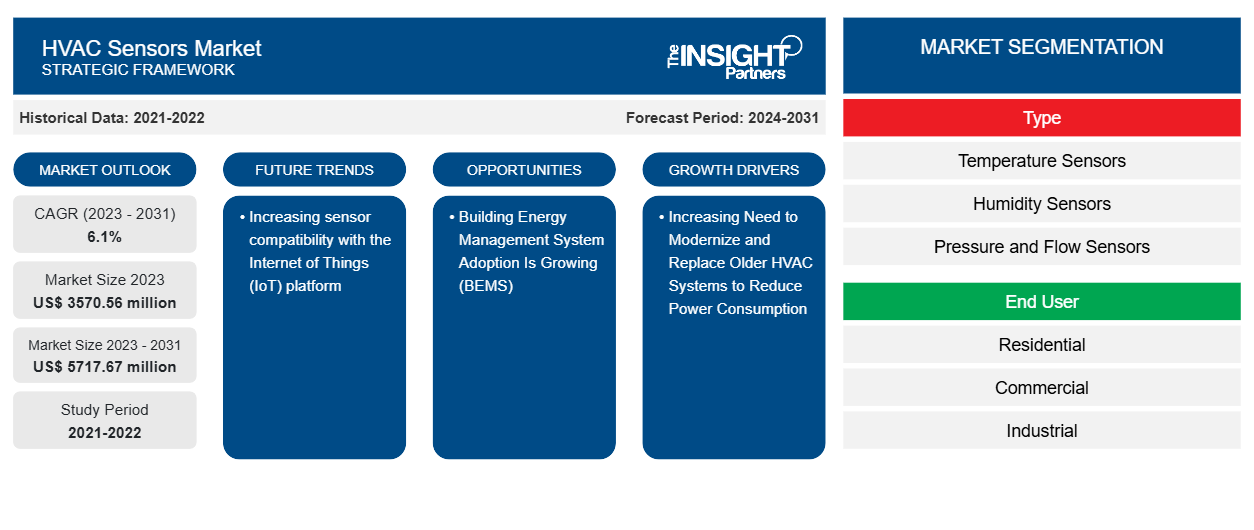HVAC 센서 시장 규모는 2023년 35억 7,056만 달러에서 2031년 57억 1,767만 달러로 성장할 것으로 예상됩니다. 이 시장은 2023~2031년 연평균 성장률 6.1%를 기록할 것으로 예상됩니다.
사물 인터넷(IoT) 플랫폼과의 센서 호환성이 높아지는 추세는 HVAC 센서 시장의 주요 추세로 남을 가능성이 높습니다.
HVAC 센서 시장 분석
HVAC 센서 시장은 상업, 주거, 자동차 등 여러 산업에서 활용되었습니다. 오늘날, 선도적인 조직이 환경 보존, 생산성, 품질, 안전 및 안전을 우선시해야 하기 때문에 비즈니스 세계에서 치열한 경쟁이 벌어지고 있습니다. 지난 몇 년 동안 HVAC 시스템은 전 세계의 많은 프로그램에서 광범위하게 사용되었습니다. 압력 및 온도 센서를 포함한 수많은 센서는 이를 가능하게 하는 용도를 찾습니다. HVAC 시스템은 자동차와 실내 모두에 우수한 공기 질과 열적 편안함을 제공합니다. HVAC 센서는 에너지 효율성에 관심이 있는 다양한 최종 사용자의 요구를 해결하는 데 사용됩니다. 이는 전력 사용량이 낮은 적절하게 유지 관리된 실내 공간을 제공하는 데 도움이 됩니다.
HVAC 센서 시장 개요
HVAC 시스템은 종종 에너지 사용을 유지, 제어하고 낮추는 데 사용됩니다. 온도나 대상 세계와 같은 실제 조건을 모방하는 오디오 장치가 주파수에 포함됩니다. 가장 중요한 종류의 HVAC 센서는 적절한 온도를 유지하고 입력 온도를 건물이나 실내 온도와 차별화하여 필요한 온도를 수정하는 데 도움이 됩니다. 산업, 주거 및 상업 건물을 포함한 최종 사용자의 경우 HVAC 센서는 기압, 온도 및 품질과 같은 다양한 작업을 관리, 제어 및 모니터링할 수 있습니다. 결과적으로 HVAC 센서는 에너지를 절약해야 하는 필요성으로 인해 점점 더 보편화되고 있습니다.
귀하의 요구 사항에 맞게 이 보고서를 사용자 정의하세요
이 보고서의 일부 또는 국가 수준 분석, Excel 데이터 팩을 포함하여 모든 보고서에 대한 사용자 정의를 무료로 받을 수 있으며 신생 기업 및 대학을 위한 훌륭한 혜택과 할인 혜택을 이용할 수 있습니다.
- 이 보고서의 주요 시장 동향을 알아보세요.이 무료 샘플에는 시장 동향부터 추정 및 예측까지 다양한 데이터 분석이 포함됩니다.
HVAC 센서 시장 동인 및 기회
전력 소비를 줄이기 위해 오래된 HVAC 시스템을 현대화하고 교체해야 할 필요성 증가
세계경제포럼은 건물이 에너지 관련 이산화탄소 배출량의 40% 이상과 전 세계 에너지 소비량의 약 3분의 1을 차지한다고 추정합니다. 세계녹색건물협의회에 따르면 이러한 배출량의 약 3분의 1은 난방, 냉방, 구조물에 전력을 공급하는 등 건물 운영에 필요한 에너지로 인해 발생합니다. Iota Communications에 따르면, 평균 사무실 건물은 연간 약 30,000달러를 전기에 사용합니다. 상업용 건물에서 HVAC 시스템은 종종 가장 많은 에너지를 사용합니다. 미국 에너지부의 추산에 따르면 HVAC 시스템은 일반적으로 건물 에너지 사용량의 35%를 차지합니다. 공기 여과 특성을 갖춘 HVAC 시스템에 대한 필요성은 팬데믹 동안 증가했습니다. 업데이트된 환기 시스템은 공기를 여과하고 바이러스가 포함된 입자와 같은 공기 중 오염 물질을 줄여 중요한 공중 보건 목적을 달성합니다.
건물 에너지 관리 시스템 도입이 증가하고 있습니다(BEMS)
건물은 엄청난 비용에도 불구하고 HVAC 시스템 없이는 기능할 수 없습니다. 호주 기후 변화, 에너지, 환경 및 수자원부는 평균 HVAC 시스템이 건물 전체 에너지 소비량의 약 40%와 기본 에너지 사용량의 70%를 사용한다고 추정합니다. 건물 에너지 관리 시스템(BEMS)으로 알려진 컴퓨터 기반 자동화 시스템은 기계 및 전기 장비를 포함하여 건물의 모든 에너지 관련 시스템을 감시하고 조절합니다. 에너지 관리 시스템은 에너지 시스템과 공급을 정확하고 자동화된 제어를 가능하게 함으로써 불필요한 에너지 지출로부터 회사를 보호합니다. Radiocrafts는 BEMS의 도움으로 회사는 현재 에너지 사용량을 최대 10%~30%까지 줄일 수 있다고 주장합니다. 러시아와 우크라이나 간의 갈등으로 인해 EU에서 에너지 가격이 급등하고 있습니다. 따라서 건물 에너지 관리 시스템 채택(BEMS)은 예측 기간 동안 HVAC 업체에 새로운 기회를 제공할 것으로 예상됩니다.
HVAC 보고서 세분화 분석
HVAC 분석 도출에 기여한 주요 세그먼트는 유형과 최종 사용자입니다.
- HVAC는 유형에 따라 온도 센서, 습도 센서, 압력 및 유량 센서, 모션 센서, 연기 및 가스 센서 등으로 세분화됩니다. 온도 센서 부문은 2023년에 더 큰 시장 점유율을 차지했습니다.
HVAC 센서 시장은 최종 사용자를 기준으로 주거용, 상업용, 산업용으로 구분됩니다.
지역별 HVAC 센서 시장 점유율 분석
HVAC 센서 시장 보고서의 지리적 범위는 주로 북미, 아시아 태평양, 유럽, 중동 및 아프리카, 남미/남중부 아메리카의 5개 지역으로 나뉩니다. 상업용 건물, 산업 시설, 주거용 부동산을 포함한 현대적이고 잘 개발된 인프라가 매우 많기 때문에 북미는 HVAC 센서 및 컨트롤러에 대한 시장 점유율이 가장 높습니다. 복잡한 HVAC 시스템이 있는 건물이 많기 때문에 HVAC 센서 및 컨트롤러에 대한 시장이 상당히 큽니다.
HVAC 센서 시장 지역 통찰력
Insight Partners의 분석가들은 예측 기간 동안 HVAC 센서 시장에 영향을 미치는 지역적 추세와 요인을 철저히 설명했습니다. 이 섹션에서는 북미, 유럽, 아시아 태평양, 중동 및 아프리카, 남미 및 중미의 HVAC 센서 시장 세그먼트와 지리에 대해서도 설명합니다.

- HVAC 센서 시장에 대한 지역별 데이터 얻기
HVAC 센서 시장 보고서 범위
| 보고서 속성 | 세부 |
|---|---|
| 2023년 시장 규모 | 35억 7,056만 달러 |
| 2031년까지 시장 규모 | 57억 1,767만 달러 |
| 글로벌 CAGR (2023-2031) | 6.1% |
| 역사적 데이터 | 2021-2022 |
| 예측 기간 | 2024-2031 |
| 다루는 세그먼트 | 유형별로
|
| 포함된 지역 및 국가 | 북아메리카
|
| 시장 선도 기업 및 주요 회사 프로필 |
|
HVAC 센서 시장 참여자 밀도: 비즈니스 역학에 미치는 영향 이해
HVAC 센서 시장 시장은 소비자 선호도의 변화, 기술 발전, 제품의 이점에 대한 인식 증가와 같은 요인으로 인해 최종 사용자 수요가 증가함에 따라 빠르게 성장하고 있습니다. 수요가 증가함에 따라 기업은 제품을 확장하고, 소비자의 요구를 충족하기 위해 혁신하고, 새로운 트렌드를 활용하여 시장 성장을 더욱 촉진하고 있습니다.
시장 참여자 밀도는 특정 시장이나 산업 내에서 운영되는 회사나 기업의 분포를 말합니다. 주어진 시장 공간에 얼마나 많은 경쟁자(시장 참여자)가 존재하는지 그 규모나 총 시장 가치에 비해 나타냅니다.
HVAC 센서 시장에서 운영되는 주요 회사는 다음과 같습니다.
- 지멘스 AG
- 에머슨 일렉트릭(주)
- 허니웰 인터내셔널 주식회사
- 존슨콘트롤즈 주식회사
- 슈나이더 일렉트릭
- TE 커넥티비티 유한회사
면책 조항 : 위에 나열된 회사는 어떤 특별한 순서에 따라 순위가 매겨지지 않았습니다.

- HVAC 센서 시장 주요 업체 개요를 알아보세요
HVAC 센서 시장 뉴스 및 최근 개발
HVAC 센서 시장은 1차 및 2차 연구 이후의 정성적, 정량적 데이터를 수집하여 평가되며, 여기에는 중요한 기업 간행물, 협회 데이터 및 데이터베이스가 포함됩니다. 다음은 언어 장애 및 전략 시장에서의 개발 목록입니다.
- 2023년 10월, Sensata Technologies는 난방, 환기 및 공조(HVAC) 장비에 사용되는 여러 A2L 냉매 가스에 대한 UL 인증을 받은 최초의 누출 감지 센서인 Sensata Resonix RGD 센서 출시를 발표했습니다. 새로운 누출 감지 센서는 HVAC 제조업체가 지구 온난화 영향이 낮은 냉매로 전환하도록 지원합니다. (출처: Sensata Technologies, 보도 자료)
- 2023년 1월, Third Reality는 온도 및 습도 센서를 출시했습니다. (출처: Third Reality, 보도자료)
HVAC 센서 시장 보고서 범위 및 제공물
"HVAC 센서 시장 규모 및 예측(2021-2031)" 보고서는 아래 영역을 포괄하는 시장에 대한 자세한 분석을 제공합니다.
- 범위에 포함된 모든 주요 시장 세그먼트에 대한 글로벌, 지역 및 국가 수준의 시장 규모 및 예측
- 동인, 제약 및 주요 기회와 같은 시장 역학
- 주요 미래 트렌드
- 자세한 PEST/포터의 5가지 힘과 SWOT 분석
- 주요 시장 동향, 주요 업체, 규정 및 최근 시장 동향을 포괄하는 글로벌 및 지역 시장 분석
- 시장 집중도, 히트맵 분석, 유명 기업 및 최근 개발 사항을 포함하는 산업 환경 및 경쟁 분석
- 자세한 회사 프로필
- 과거 분석(2년), 기준 연도, CAGR을 포함한 예측(7년)
- PEST 및 SWOT 분석
- 시장 규모 가치/거래량 - 글로벌, 지역, 국가
- 산업 및 경쟁 환경
- Excel 데이터세트
최근 보고서
관련 보고서
사용 후기
구매 이유
- 정보에 기반한 의사 결정
- 시장 역학 이해
- 경쟁 분석
- 고객 인사이트
- 시장 예측
- 위험 완화
- 전략 기획
- 투자 타당성 분석
- 신흥 시장 파악
- 마케팅 전략 강화
- 운영 효율성 향상
- 규제 동향에 발맞춰 대응





















 무료 샘플 받기 - HVAC 센서 시장
무료 샘플 받기 - HVAC 센서 시장